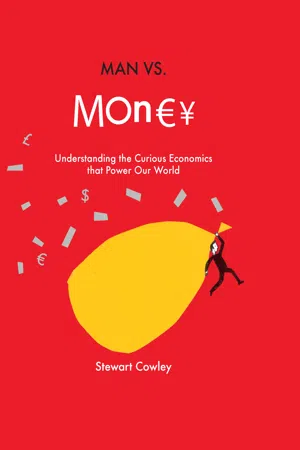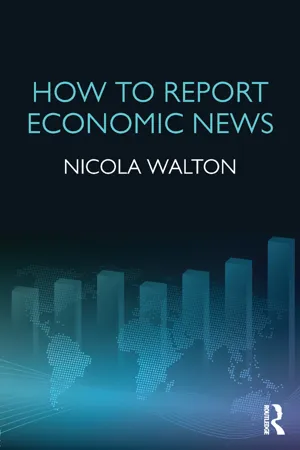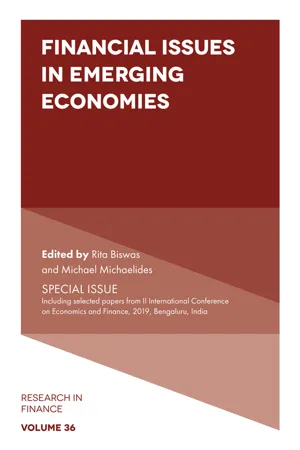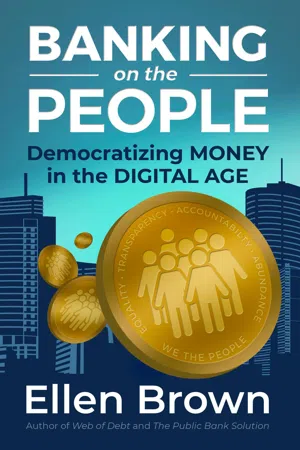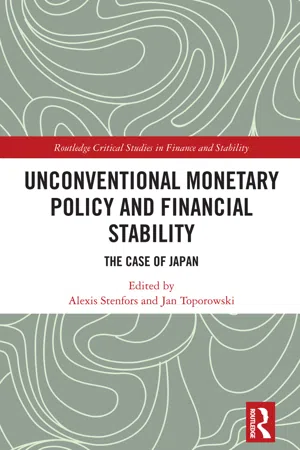Credit Easing vs Quantitative Easing
Credit easing and quantitative easing are both monetary policy tools used by central banks to stimulate the economy. Credit easing focuses on providing targeted support to specific sectors by purchasing assets such as corporate bonds, while quantitative easing involves the central bank purchasing government securities to increase the money supply and lower long-term interest rates. Both aim to boost economic activity but through different mechanisms.
7 Key excerpts on "Credit Easing vs Quantitative Easing"
- eBook - ePub
Man vs Money
Understanding the curious economics that power our world
- Stewart Cowley(Author)
- 2016(Publication Date)
- Aurum(Publisher)
...Once we used only interest rates and government spending (with some tinkering with taxation on the side) to get us out of economic slumps. But then someone remembered quantitative easing (QE). Although QE had been used in Japan for decades, it wasn’t something anyone in the west had had to resort to in a generation or more. Quantitative easing is the mechanism whereby central banks buy financial assets in order to keep the financial system afloat. They do this by pressing a button to say, ‘This money now exists’, in the process ‘manufacturing’ the money out of thin air. It’s one of the perks of being a central bank. The central banks now go out into the financial markets and buy financial assets (primarily bonds but some stocks also) for their own account, and hand out money to the sellers in the process. The money now in society is assumed to be employed doing some good, such as being spent on consumption and investment in new businesses, buoying the economy. But the main effect is to increase the value of bonds, stocks and (by association) real estate – the things that comprise most people’s wealth. The amount of money involved today in the global QE programme is truly, mind-bogglingly, large. The US has bought over $4.5 trillion of assets from the markets. If you printed it out in dollar bills and spread it out over Manhattan you would be literally wading through them knee-deep. The Bank of England bought nearly £400 billion of securities and now owns some 40% of its own government bond market. Japan, which has been at this longer, owns ¥55 trillion of assets, which is nearly all of its own government bond market. In the process the Japanese government bond market has all but ceased to function as a market. Lately, the European Central Bank has adopted a ‘whatever it takes’ programme but it is unlikely to pause before it has accumulated €1.1 trillion of European financial assets. Even then the ECB have stated that they may not stop there...
- eBook - ePub
Quantitative Easing
The Great Central Bank Experiment
- Jonathan Ashworth(Author)
- 2020(Publication Date)
- Agenda Publishing(Publisher)
...In the euro area, since the beginning of QE in 2015, around 7 per cent and 10 per cent of the increase in the ECB’s assets has been accounted for by corporate and covered bonds respectively (Baltensperger & Call 2018). Moreover, £10 billion of the £75 billion of asset purchases by the BoE in QE3 beginning in 2016 were in corporate bonds. The purchase of private sector assets is often referred to in the literature as “credit policy” and results in central banks taking on credit risk (Borio & Zabai 2016). In some countries such as the UK the government has indemnified the central bank against any losses (including credit) from asset purchases. QE is likely to have diminishing returns over time There are a number of practical and theoretical reasons why the power of QE was likely to be at its greatest during the GFC and is likely to have suffered diminishing returns over time. ECB President Mario Draghi (2019a) recently acknowledged that unconventional monetary policy may suffer from decreasing returns, while suggesting that this would not prevent the ECB from doing more. QE is no longer a new tool: Broadbent (2018) notes, “One thing that may have amplified QE when it was first used was its sheer novelty value. Once markets discover the policy is feasible, perhaps the premium for holding longer-term bonds is permanently lowered, if only to a small extent”. 8 Its novelty value when first unveiled as this drastic new policy tool also probably meant that its initial use had powerful positive impacts on the expectations of investors, firms and the general public. While it no doubt played an important part in driving economic recoveries in countries such as the US and UK, the fact that these recoveries remained weak by historical standards and began to lose momentum in the second half of 2010 probably meant that its subsequent use may have influenced expectations somewhat less...
- eBook - ePub
- Nicola Walton(Author)
- 2017(Publication Date)
- Routledge(Publisher)
...These organisations then use the money raised from the sales to purchase other assets such as corporate bonds and shares. Buying bonds pushes up the price and lowers the yield (see glossary for definitions of a bond and yield), which should lead to lower borrowing costs for businesses and consumers. QE was the co-ordinated response of policy makers in mature industrialised economies to stagnant growth. QE was introduced largely because interest rates could not be reduced much further, having been slashed to just 0.5% in the immediate aftermath of the financial crash. QE had never been done prior to the financial crash. Journalistic practice There has been a huge amount of coverage of QE. This includes explanation of what it is, why it is being done and the likely impact on the financial markets. A number of other angles can be taken. These include detailing the winners – shares, property, commodities and higher-risk bonds and losers from QE, such as savers and pensioners. The possible long-term economic consequences of QE also provide fertile ground for opinion and comment pieces. When a central bank announces a change in its QE policy, any news report should quote the statement with the reasons for the decision. Include an opinion from a financial analyst or economist with a mention of what the share price reaction was to the announcement. The report can be brought bang up to date with the latest economic data that vindicates the action taken by the central bank e.g. better economic growth or unemployment figures. A wider global perspective can be taken by charting the negative impact on emerging markets such as India and Brazil of a reversal of QE in the larger mature markets. Such reports can include details of movements in the associated emerging stock and currency markets and critical comments from politicians and central bankers in these countries...
- eBook - ePub
Financial Issues in Emerging Economies
Special Issue Including Papers from the International Conference on Economics and Finance, India
- Rita Biswas, Michael Michaelides, Rita Biswas, Michael Michaelides(Authors)
- 2020(Publication Date)
- Emerald Publishing Limited(Publisher)
...By the end of 2008, the federal funds rate was reduced to zero. Till December 2015, the rate was maintained at zero – the zero-interest rate policy (ZIRP). But ZIRP was not enough to reduce real interest rates and revive demand. The policy is also closely related to liquidity trap, since nominal interest rates cannot adjust downwards. However, some monetary economists believed that Unconventional monetary policy (UMP) like quantitative easing (QE) could be effective when used alongside ZIRP (Reifschneider, 2016 ; Yellen, 2016). In QE, a central bank expands its balance sheet by purchasing government securities or other securities from the market in order to lower interest rates and increase the money supply in the economy. The increased liquidity to the financial institutions in turn is expected to increase lending and brings back growth. Balance sheet expansion is the most common form of QE. Other such policies involve direct lending to specific credit markets. The origin of QE can be traced back to Japan in the 1990s. During that time, Japan was dealing with the burst of a real estate bubble and the deflationary pressure which had followed. Since the policy rates were already zero, Bank of Japan (BoJ) aimed to increase the cash levels held by banks by purchasing government securities. This was the first time any central bank had targeted a level of reserves, which was a major shift from the existing policies. Since then, three other major central banks – US Fed, BoJ, European Central Bank and Bank of England also resorted to QE in last two decades. While QE was adopted by the developed economies to boost its asset prices, the transmission channels were not always limited to only the economy implementing the QE. There were spillover effects on other economies as well, especially Emerging Market Economies (EMEs). The transmission of QE to the asset prices may occur through several channels...
- eBook - ePub
Banking Crises
Perspectives from the New Palgrave Dictionary of Economics
- Garett Jones, Garett Jones(Authors)
- 2016(Publication Date)
- Palgrave Macmillan(Publisher)
...The European Central Bank eschewed large-scale asset purchases, but instituted a number of major lending programmes that significantly increased the size of its balance sheet. Existing studies suggest that the initial rounds of QE provided a significant boost to both growth and inflation in the USA and UK, whilst the evidence on the impact of the ECB’s actions has also been favourable. Another key positive of QE in the USA and UK has been in helping to limit the deterioration in near-term debt dynamics, whilst the ECB’s lending programs also indirectly reduced governments’ borrowing costs. One area of disappointment, however, was the inability of unconventional policies to generate a material revival in bank lending. Moreover, there has been some evidence of diminishing returns in later rounds of QE. Meanwhile, fears that QE would fuel a sharp acceleration in inflation have so far proven misplaced, although central banks will need to be increasingly alert to the risks once more sustainable economic recoveries begin to emerge. Policymakers must also pay significant attention to the financial stability risks associated with the long period of extremely accommodative monetary policy. Acknowledgements Unless otherwise indicated, the views in this paper are those of the author and not of Morgan Stanley. The author is grateful to Charles Goodhart for his comments. This article is not an offer to buy or sell any security/instruments or to participate in a trading strategy. For important current disclosures that pertain to Morgan Stanley, please refer to the disclosures regarding the issuer(s) that are the subject of this article on Morgan Stanley’s disclosure website. https://www.morganstanley.com/ researchdisclosures. J...
- eBook - ePub
Banking on the People
Democratizing Money in the Digital Age
- Ellen Brown(Author)
- 2019(Publication Date)
- Democracy Collaborative(Publisher)
...Chapter 15: “QUALITATIVE EASING”: INJECTING MONEY DIRECTLY INTO THE VEINS OF THE ECONOMY “[W]e may have to resort to QE yet again. If so, let us stop buying bonds, and stop creating windfall profits for the holders of assets in the hope that some largesse will trickle down. If we have to do it again, let us inject the money directly into the veins of the economy... .” —Ambrose Evans-Pritchard, UK Telegraph, November 2014 461 Quantitative easing has not inflated consumer prices because the new money it created has been trapped in bank reserve accounts or has otherwise not trickled down to the consumer marketplace. But what about injecting money directly into the veins of the economy, as urged by Ambrose Evans-Prichard? The central bank could inject money to build infrastructure, make interest-free loans for state and local governments, or make low-interest loans to targeted economic sectors and local businesses. All of these options would increase employment, fulfilling one of the Fed’s dual mandates. But under classical monetarist theory, consumer prices would also shoot up. That is the theory, but empirical data refutes it. As John Maynard Keynes observed, when money is injected for productive purposes and workers and materials are available, supply and demand will increase together and prices will remain stable. Rather than supply creating demand (“Say’s law”), demand creates supply. New money injected into the economy triggers the production of new goods and services to satisfy the demand. 462 Historical data confirms this premise. 463 Among other noteworthy examples is the Bank of Canada’s monetary policy from 1935 to 1973, when the central bank was not “independent” but actually served the government and the public. As Joyce Nelson explains in Bypassing Dystopia (2018), the Bank of Canada Act gave Canada’s publicly owned central bank the power to make near-zero interest loans to federal and provincial governments for infrastructure and health care spending...
- eBook - ePub
Unconventional Monetary Policy and Financial Stability
The Case of Japan
- Alexis Stenfors, Jan Toporowski, Alexis Stenfors, Jan Toporowski(Authors)
- 2020(Publication Date)
- Routledge(Publisher)
...However, he has not yet accomplished the Bank’s inflation target of 2%, despite almost escaping a long and persistent deflationary period. In contrast to Japan, the US enjoyed an immediate economic expansion under the Trump administration. With the tax reduction in the year of the interim election, the Federal Reserve (Fed) raised the federal funds rates four times in 2018. But in 2019, amid emerging uncertainty regarding the US- China trade war, Brexit, rising of US-Iran tensions, and possible regulatory reinforcement of mega global information companies (the four internet giants, Google, Apple, Facebook and Amazon, collectively known as “GAFA”), the US growth prospects have shrunk. Consequently, the Fed lowered the policy rate three times gradually in 2019. In Europe, the European Central Bank (ECB) terminated a quantitative easing policy at the end of 2018, however, the European economy remains weak. Under these circumstances, it is widely believed that the monetary policy will remain soft for the foreseeable future. This chapter investigates how Governor Kuroda’s unconventional monetary policy, including the negative interest rate policy, affects financial markets and the behaviour of financial institutions – especially from the perspective of financial stability and monetary and fiscal policy coordination. The findings can be summarised as follows. Quantitative and Qualitative Easing (QQE) is found to have had a significantly positive impact on inflation expectations at first. Banks have pod their holdings from risk-free to riskier bonds, and lending by banks has picked up. However, the negative interest rate policy introduced in February 2016 has harmed the financial system. Furthermore, through an empirical study, it is shown that the negative interest rate policy, coupled with management efficiency, has influenced bank profitability and the return on equity of regional banks. The chapter is organised as follows...
